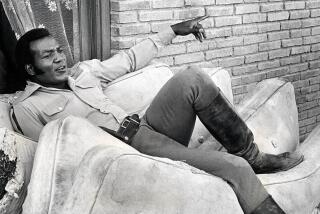The Pursuit of Ruth
- Share via
Truth and baseball film biographies often have been mutually exclusive entities as filmmakers embellish or distort history in quest of a better product.
Producer Larry Lyttle is hoping to change that with his version of “Babe Ruth,” airing tonight on NBC.
“The commitment I made to this piece was that we would tell the truth,” Lyttle said.
Such was not the case in 1948 when “The Babe Ruth Story” was rushed into production and into the theaters as the legendary slugger was dying of cancer.
That version, which starred William Bendix, was later derided for depicting incidents which never happened--such as Ruth promising to hit a home run for an ill child--and for not dealing with some of Ruth’s excesses with liquor and women.
“You see Babe behaving in ways that are not in the boys’ book version of Babe,” said Stephen Lang, who portrays Ruth. “You don’t see me drink a glass of milk in the film.”
Lyttle’s pursuit of the truth began with his source material, Robert Creamer’s 1974 biography “Babe: The Legend Comes to Life” and “Babe Ruth: His Life and Legend,” by Kal Wagenheim. Michael de Guzman, who received a 1990 Emmy nomination for writing “Caroline?” adapted the books into a teleplay.
To make Lang, a natural right-handed hitter, credible as the left-hitting Ruth, the film hired as a consultant Rod Carew, the seven-time American League batting champion.
For authenticity in the baseball sequences, former minor league and collegiate players were signed.
In a bit of irony, which would not only give the production much publicity but land it in hot water with the baseball commissioner’s office, Pete Rose was cast to play Ty Cobb, then the Detroit Tigers player-manager.
Rose’s brash playing style and successful pursuit of Cobb’s all-time hit record elicited many comparisons between him and Cobb.
Rose originally was going to be in two scenes in “Babe Ruth.” The first takes place in Cobb’s hotel suite, with Ruth telling Cobb of his desire to manage the New York Yankees. The second was set in Yankee Stadium, with Cobb and Ruth involved in an argument after an umpire calls Ruth safe at second base.
But as part of the 1989 agreement that barred Rose from baseball, the former Cincinnati Red is forbidden from appearing in any product licensed by major league baseball. Because Rose/Cobb would have been wearing a Tigers uniform, the second scene was dropped.
While professing a commitment to the truth, Lyttle said his other goal was not to demythologize Ruth.
What viewers will see at times is a 1920s version of Oakland Athletics outfielder Jose Canseco, with Ruth shown womanizing, feuding with manager Miller Huggins (Bruce Weitz) and owner Jacob Ruppert (Donald Moffat) and threatening to go into the stands to confront a heckler.
Ruth’s tender side is also depicted after a miscarriage by his first wife Helen (Yvonne Suhor) and her death in a fire years later.
The project had its roots in Lyttle’s lifelong interest in baseball and found fruition thanks to an individual Lyttle played softball with each Saturday: then-NBC Entertainment President Brandon Tartikoff.
Tartikoff and Lyttle had lunch after one game two years ago, and the conversation turned to making a movie about Ruth.
Lyttle first thought of Brian Dennehy in the title role, but rejected him as too old. Tartikoff agreed that Ruth’s story was a great one, and had a casting suggestion of his own.
“Brandon said, ‘If you can get John Goodman, I’ll make the movie,’ ” Lyttle said. “For three months plus I chased John Goodman, ultimately got him, and ultimately lost him.”
In fact, in the spring of 1990, NBC announced that Goodman would star as Ruth in a made-for-TV movie. But, according to Lyttle, Goodman received a better offer from Universal to make a theatrical movie about Ruth, “The Babe,” scheduled to be released in 1992.
“To put it mildly, we went ballistic,” Lyttle said.
After Lyttle considered casting another actor whom he did not identify, Lang’s agents called Lyttle.
Lyttle had met Lang and was familiar with his work, having seen him with Dustin Hoffman and John Malkovich on Broadway in “Death of a Salesman” and as attorney David Abrams on NBC’s “Crime Story.” Lyttle felt that Lang did not have the presence for the role. A second drawback was that, at 160 pounds, Lang was too light to portray Ruth, who weighed 195 pounds when the Yankees purchased him from the Boston Red Sox in 1920, the film’s starting point.
Lang’s agents said their client would gain the weight and fly to Los Angeles at his own expense to read for the role.
“I was not skeptical because I knew what a brilliant actor he was, but I just didn’t see him in the role,” Lyttle said. “When he came into my office, I lost my breath. When I brought in Lang to NBC, they lost their breath also. On Oct. 7, Stephen Lang is going to be known by people in America. He became Babe Ruth.”
“Babe Ruth” airs tonight at 9 on NBC.
More to Read
Only good movies
Get the Indie Focus newsletter, Mark Olsen's weekly guide to the world of cinema.
You may occasionally receive promotional content from the Los Angeles Times.










